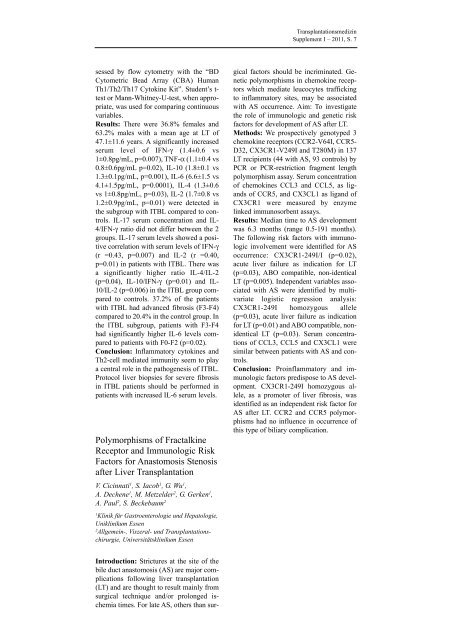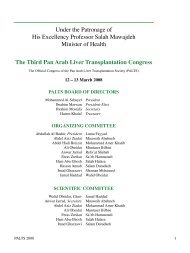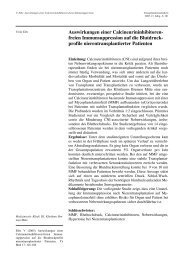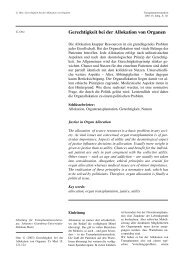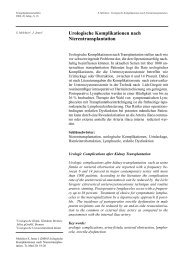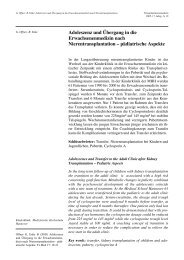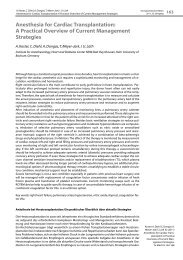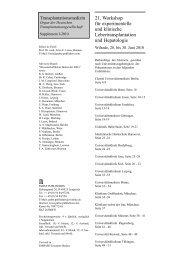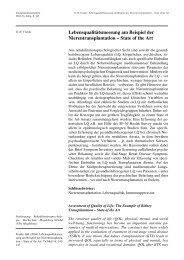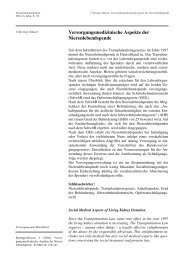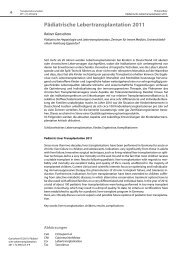22. Workshop für experimentelle und klinische Lebertransplantation ...
22. Workshop für experimentelle und klinische Lebertransplantation ...
22. Workshop für experimentelle und klinische Lebertransplantation ...
Sie wollen auch ein ePaper? Erhöhen Sie die Reichweite Ihrer Titel.
YUMPU macht aus Druck-PDFs automatisch weboptimierte ePaper, die Google liebt.
Transplantationsmedizin<br />
Supplement I – 2011, S. 7<br />
sessed by flow cytometry with the “BD<br />
Cytometric Bead Array (CBA) Human<br />
Th1/Th2/Th17 Cytokine Kit”. Student’s t-<br />
test or Mann-Whitney-U-test, when appropriate,<br />
was used for comparing continuous<br />
variables.<br />
Results: There were 36.8% females and<br />
63.2% males with a mean age at LT of<br />
47.1±11.6 years. A significantly increased<br />
serum level of IFN-γ (1.4±0.6 vs<br />
1±0.8pg/mL, p=0.007), TNF-α (1.1±0.4 vs<br />
0.8±0.6pg/mL p=0.02), IL-10 (1.8±0.1 vs<br />
1.3±0.1pg/mL, p=0.001), IL-6 (6.6±1.5 vs<br />
4.1±1.5pg/mL, p=0.0001), IL-4 (1.3±0.6<br />
vs 1±0.8pg/mL, p=0.03), IL-2 (1.7±0.8 vs<br />
1.2±0.9pg/mL, p=0.01) were detected in<br />
the subgroup with ITBL compared to controls.<br />
IL-17 serum concentration and IL-<br />
4/IFN-γ ratio did not differ between the 2<br />
groups. IL-17 serum levels showed a positive<br />
correlation with serum levels of IFN-γ<br />
(r =0.43, p=0.007) and IL-2 (r =0.40,<br />
p=0.01) in patients with ITBL. There was<br />
a significantly higher ratio IL-4/IL-2<br />
(p=0.04), IL-10/IFN-γ (p=0.01) and IL-<br />
10/IL-2 (p=0.006) in the ITBL group compared<br />
to controls. 37.2% of the patients<br />
with ITBL had advanced fibrosis (F3-F4)<br />
compared to 20.4% in the control group. In<br />
the ITBL subgroup, patients with F3-F4<br />
had significantly higher IL-6 levels compared<br />
to patients with F0-F2 (p=0.02).<br />
Conclusion: Inflammatory cytokines and<br />
Th2-cell mediated immunity seem to play<br />
a central role in the pathogenesis of ITBL.<br />
Protocol liver biopsies for severe fibrosis<br />
in ITBL patients should be performed in<br />
patients with increased IL-6 serum levels.<br />
Polymorphisms of Fractalkine<br />
Receptor and Immunologic Risk<br />
Factors for Anastomosis Stenosis<br />
after Liver Transplantation<br />
V. Cicinnati 1 , S. Iacob 1 , G. Wu 1 ,<br />
A. Dechene 1 , M. Metzelder 2 , G. Gerken 1 ,<br />
A. Paul 2 , S. Beckebaum 2<br />
1<br />
Klinik für Gastroenterologie <strong>und</strong> Hepatologie,<br />
Uniklinikum Essen<br />
2<br />
Allgemein-, Viszeral- <strong>und</strong> Transplantationschirurgie,<br />
Universitätsklinikum Essen<br />
Introduction: Strictures at the site of the<br />
bile duct anastomosis (AS) are major complications<br />
following liver transplantation<br />
(LT) and are thought to result mainly from<br />
surgical technique and/or prolonged ischemia<br />
times. For late AS, others than surgical<br />
factors should be incriminated. Genetic<br />
polymorphisms in chemokine receptors<br />
which mediate leucocytes trafficking<br />
to inflammatory sites, may be associated<br />
with AS occurrence. Aim: To investigate<br />
the role of immunologic and genetic risk<br />
factors for development of AS after LT.<br />
Methods: We prospectively genotyped 3<br />
chemokine receptors (CCR2-V64I, CCR5-<br />
D32, CX3CR1-V249I and T280M) in 137<br />
LT recipients (44 with AS, 93 controls) by<br />
PCR or PCR-restriction fragment length<br />
polymorphism assay. Serum concentration<br />
of chemokines CCL3 and CCL5, as ligands<br />
of CCR5, and CX3CL1 as ligand of<br />
CX3CR1 were measured by enzyme<br />
linked immunosorbent assays.<br />
Results: Median time to AS development<br />
was 6.3 months (range 0.5-191 months).<br />
The following risk factors with immunologic<br />
involvement were identified for AS<br />
occurrence: CX3CR1-249I/I (p=0.02),<br />
acute liver failure as indication for LT<br />
(p=0.03), ABO compatible, non-identical<br />
LT (p=0.005). Independent variables associated<br />
with AS were identified by multivariate<br />
logistic regression analysis:<br />
CX3CR1-249I homozygous allele<br />
(p=0.03), acute liver failure as indication<br />
for LT (p=0.01) and ABO compatible, nonidentical<br />
LT (p=0.03). Serum concentrations<br />
of CCL3, CCL5 and CX3CL1 were<br />
similar between patients with AS and controls.<br />
Conclusion: Proinflammatory and immunologic<br />
factors predispose to AS development.<br />
CX3CR1-249I homozygous allele,<br />
as a promoter of liver fibrosis, was<br />
identified as an independent risk factor for<br />
AS after LT. CCR2 and CCR5 polymorphisms<br />
had no influence in occurrence of<br />
this type of biliary complication.


